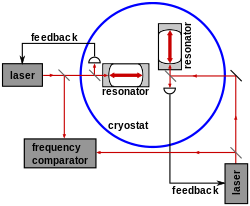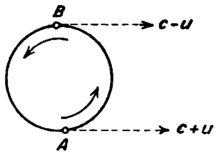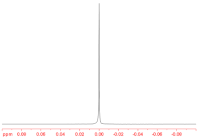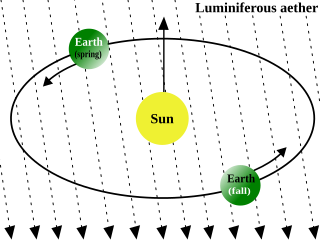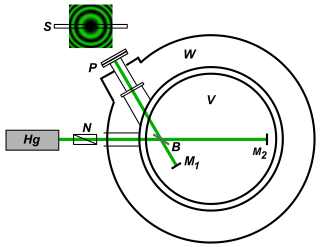Experiments paving the way to relativity
The predominant theory of light in the 19th century was that of the luminiferous aether, a stationary medium in which light propagates in a manner analogous to the way sound propagates through air. By analogy, it follows that the speed of light is constant in all directions in the aether and is independent of the velocity of the source. Thus an observer moving relative to the aether must measure some sort of "aether wind" even as an observer moving relative to air measures an apparent wind.
First-order experiments

Beginning with the work of François Arago (1810), a series of optical experiments had been conducted, which should have given a positive result for magnitudes of first order in (i.e., of ) and which thus should have demonstrated the relative motion of the aether. Yet the results were negative. An explanation was provided by Augustin Fresnel (1818) with the introduction of an auxiliary hypothesis, the so-called "dragging coefficient", that is, matter is dragging the aether to a small extent. This coefficient was directly demonstrated by the Fizeau experiment (1851). It was later shown that all first-order optical experiments must give a negative result due to this coefficient. In addition, some electrostatic first-order experiments were conducted, again having negative results. In general, Hendrik Lorentz (1892, 1895) introduced several new auxiliary variables for moving observers, demonstrating why all first-order optical and electrostatic experiments have produced null results. For example, Lorentz proposed a location variable by which electrostatic fields contract in the line of motion and another variable ("local time") by which the time coordinates for moving observers depend on their current location. [1]
Second-order experiments

The stationary aether theory, however, would give positive results when the experiments are precise enough to measure magnitudes of second order in (i.e., of ). Albert A. Michelson conducted the first experiment of this kind in 1881, followed by the more sophisticated Michelson–Morley experiment in 1887. Two rays of light, traveling for some time in different directions were brought to interfere, so that different orientations relative to the aether wind should lead to a displacement of the interference fringes. But the result was negative again. The way out of this dilemma was the proposal by George Francis FitzGerald (1889) and Lorentz (1892) that matter is contracted in the line of motion with respect to the aether (length contraction). That is, the older hypothesis of a contraction of electrostatic fields was extended to intermolecular forces. However, since there was no theoretical reason for that, the contraction hypothesis was considered ad hoc.
Besides the optical Michelson–Morley experiment, its electrodynamic equivalent was also conducted, the Trouton–Noble experiment. By that it should be demonstrated that a moving condenser must be subjected to a torque. In addition, the Experiments of Rayleigh and Brace intended to measure some consequences of length contraction in the laboratory frame, for example the assumption that it would lead to birefringence. Though all of those experiments led to negative results. (The Trouton–Rankine experiment conducted in 1908 also gave a negative result when measuring the influence of length contraction on an electromagnetic coil.) [1]
To explain all experiments conducted before 1904, Lorentz was forced to again expand his theory by introducing the complete Lorentz transformation. Henri Poincaré declared in 1905 that the impossibility of demonstrating absolute motion (principle of relativity) is apparently a law of nature.
Refutations of complete aether drag
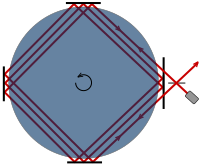
The idea that the aether might be completely dragged within or in the vicinity of Earth, by which the negative aether drift experiments could be explained, was refuted by a variety of experiments.
- Oliver Lodge (1893) found that rapidly whirling steel disks above and below a sensitive common path interferometric arrangement failed to produce a measurable fringe shift.
- Gustaf Hammar (1935) failed to find any evidence for aether dragging using a common-path interferometer, one arm of which was enclosed by a thick-walled pipe plugged with lead, while the other arm was free.
- The Sagnac effect showed that aether wind caused by earth drag cannot be demonstrated.
- The existence of the aberration of light was inconsistent with aether drag hypothesis.
- The assumption that aether drag is proportional to mass and thus only occurs with respect to Earth as a whole was refuted by the Michelson–Gale–Pearson experiment, which demonstrated the Sagnac effect through Earth's motion.
Lodge expressed the paradoxical situation in which physicists found themselves as follows: "...at no practicable speed does ... matter [have] any appreciable viscous grip upon the ether. Atoms must be able to throw it into vibration, if they are oscillating or revolving at sufficient speed; otherwise they would not emit light or any kind of radiation; but in no case do they appear to drag it along, or to meet with resistance in any uniform motion through it." [6]






